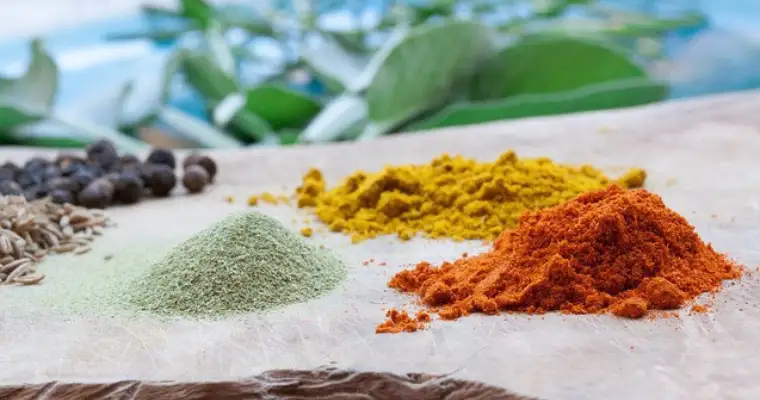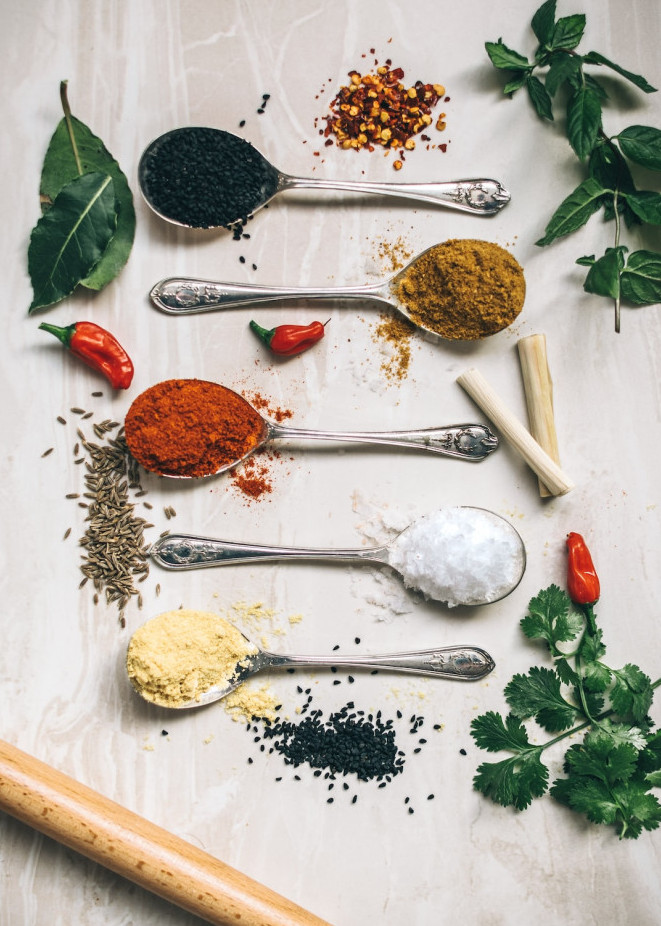Culinary Spices and Herbs

The Use of Culinary Spices in Plant-Based Cuisine
Introduction:
When it comes to creating flavorful and enticing plant-based dishes, the use of culinary spices and herbs play a vital role.
Moreover, these aromatic ingredients not only enhance the flavor and aroma of your meals but also offer numerous health benefits.
Additionally, from adding a dash of warmth to infusing vibrant colors, spices and herbs are the secret to elevating plant-based cuisine to new heights.
Let’s explore the use of culinary spices and herbs in all your plant-based dishes.

List of common Spices and Herbs used in many Plant Based dishes.
Turmeric: A Golden Touch of Wellness
Turmeric, the golden spice, is a must-have in any plant-based kitchen. With its earthy flavor and vibrant yellow hue, turmeric adds depth to curries, stews, and roasted vegetables.
It contains curcumin, a potent antioxidant known for its anti-inflammatory properties. Sprinkle a pinch of turmeric to add a touch of wellness to your dishes.
Cumin: An Aromatic Journey
Cumin is a warm and aromatic spice that adds a distinct flavor to plant-based meals.
Its nutty and peppery notes make it an excellent choice for curries, soups, and roasted vegetables. With its digestive benefits and iron content, cumin is a versatile spice that enhances both taste and health.
Coriander: Nature’s Freshness
Coriander, also known as cilantro, is a herb that brings a burst of freshness to plant-based dishes.
Its delicate leaves and citrusy flavor are perfect for salads, salsas, and dressings. Coriander seeds, with their warm and slightly sweet taste, are excellent for seasoning lentils, grains, and roasted vegetables. Embrace the vibrancy of coriander and experience the rejuvenating essence it adds to your meals.
Smoky Paprika: A Dash of Boldness
Smoky paprika adds a touch of depth and intensity to plant-based cuisine.
With its rich red color and smoky flavor, this spice is ideal for adding a hint of barbecue-like essence to tofu, roasted potatoes, and vegetable stews. Use smoky paprika sparingly to add a subtle boldness to your dishes.
Fresh Basil: The King of Herbs
Basil is a versatile herb that is cherished for its fragrant aroma and sweet, slightly peppery taste.
It pairs well with tomatoes, making it a classic choice for pasta sauces, bruschetta, and salads. Basil also adds a refreshing touch to soups, stir-fries, and even desserts. Embrace the allure of basil and let its essence elevate your plant-based creations.
Thai Basil: An Herb of Exquisite Flavor
Thai Basil, also known as “Holy Basil” or “Sweet Basil,” is a herb that adds a unique and vibrant flavor to dishes.
It is a key ingredient in Thai and Southeast Asian cuisines, renowned for its distinct aroma and slightly spicy taste. Let’s discover the captivating qualities of Thai Basil and how it can elevate your plant-based culinary adventures.
Furthermore, Thai Basil leaves are often used fresh in salads, stir-fries, curries, and even beverages, infusing the dishes with a delightful fragrance and a hint of peppery undertones.
Ginger: A Zingy Marvel
Ginger is a zingy spice that adds a kick to plant-based dishes. It’s warm and peppery flavor complements both sweet and savory recipes.
Whether grated, minced, or in powdered form, ginger imparts a distinctive taste to stir-fries, smoothies, curries, and desserts. Beyond its flavorful qualities, ginger is also known for its digestive and anti-inflammatory properties.
Rosemary: A Fragrant Wonder
Rosemary, with its woody aroma and pine-like flavor, is a herb that brings a delightful fragrance to plant-based dishes.
It pairs exceptionally well with roasted potatoes, bread, and marinades. Sprinkle some rosemary to infuse your dishes with a touch of elegance and a mesmerizing scent.
The Fiery Duo: Black and Cayenne Peppers
In the realm of spices, few can rival the distinct flavors and fiery heat brought forth by black and cayenne peppers. These two spices have gained worldwide popularity for their ability to add a spicy kick to various dishes.
Now, let’s delve deeper into the unique characteristics of black and cayenne peppers and explore how they can elevate your culinary creations.
Black Pepper: The King of Spices
Black pepper, often referred to as the “king of spices,” is one of the most widely used and beloved spices in the world. Derived from dried unripe peppercorns, black pepper has a pungent and slightly spicy flavor that enhances the taste of a multitude of dishes.
Its distinct aroma and subtle heat make it a versatile spice that can be used in both savory and sweet preparations.
Additionally, black pepper offers several health benefits, thanks to its compound called piperine, which has antioxidant and anti-inflammatory properties.
By adding freshly ground black pepper to your favorite plant-based dishes.
Cayenne Pepper: Heat with a Punch
For those craving an extra dose of heat, cayenne pepper is the perfect choice. Derived from dried and ground red chili peppers, cayenne pepper is known for its intense spiciness. It adds a fiery punch that instantly elevates the flavor profile of any dish.
The active compound responsible for cayenne pepper’s heat is called capsaicin. This compound not only adds a fiery sensation but also offers health benefits such as pain relief, aiding in weight loss by boosting metabolism.
To incorporate the delightful heat of cayenne pepper into your plant-based meals, use it in moderation and enjoy the fiery flavors it brings.
Cooking with Black and Cayenne Peppers
Black and cayenne peppers are incredibly versatile spices that can be incorporated into a wide range of plant-based dishes. Here are a few ideas to familiar with the use of these culinary powerhouses.
- Spicy Stir-Fries: Enhance your vegetable stir-fries with a pinch of freshly ground black pepper and a dash of cayenne pepper for an extra kick of heat.
- Marinades and Rubs: Create flavorful marinades or rubs for tofu, tempeh, or seitan by combining black pepper, cayenne pepper, garlic, and other spices.
- Spicy Soups and Stews: Add depth of flavor to your plant-based soups and stews by incorporating a pinch of black pepper and a touch of cayenne pepper.
- Seasoned Roasted Vegetables: Sprinkle a mixture of black pepper, cayenne pepper, and other herbs onto roasted vegetables to infuse them with a spicy twist.
- Spicy Chocolate Treats: Experiment with the unique combination of black pepper or cayenne pepper in your plant-based chocolate creations for a delightful and unexpected dessert experience.
Finally, remember to start with small amounts of both fresh black and cayenne peppers, as they can be quite potent. Adjust the quantities according to your taste preferences and enjoy the tantalizing heat and flavors these spices bring to all your homemade plant-based dishes.
Let your culinary imagination run wild and savor the fiery duo of black and cayenne peppers!
Culinary Spices and Herbs Conclusion:
Above all, In the world of plant-based cuisine culinary spices and herbs are the true heroes that elevate simple dishes to extraordinary creations. From the golden touch of turmeric to the fragrant wonder of rosemary, each spice and herb brings its unique characteristics, flavors, and health benefits to the table.
So, go ahead and explore the vast array of culinary spices and herbs, and let your plant-based culinary adventures flourish with tantalizing taste and vibrant colors.
Embrace the magic of spices and herbs and watch your plant-based dishes come to life with a symphony of flavors.
Be sure to sign up for your > Free 12 Tips Food Guide <
Cheers,
Plantaful Life Team
Disclaimer: The information shared in this blog post and on our website is for educational and informational purposes only. We are here to inspire and support you on your plant-based journey. However, always prioritize your health and consult with your trusted healthcare provider for personalized advice. By using our website, you acknowledge and agree that you have read and understood this medical disclaimer, and you acknowledge the significance of seeking professional medical advice for your specific health needs.